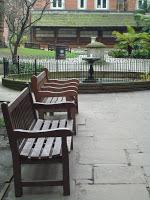 Although every story on the Watts Memorial has its own interest, there are certain causes of death which appear again and again. While they are of course not a representative sample in any way, they do highlight both the dangers and the preoccupations of Victorian and Edwardian London.
Although every story on the Watts Memorial has its own interest, there are certain causes of death which appear again and again. While they are of course not a representative sample in any way, they do highlight both the dangers and the preoccupations of Victorian and Edwardian London.The figures below relate to numbers of plaques rather than individuals (some tiles feature more than one person killed in the same incident):
Death by drowning: 21 (including 1 in quicksand)Although the memorial is not formally limited to London, in practice very few of the plaques are not connected to the metropolis. Again, here are some figures:
Death in a fire: 15
Train: 5 (4 run down; 1 while driving train)
Run down by horse/carriage: 4
Killed by poison gas in workplace: 3
Killed in WW1: 2
Treating diphtheria patient: 2
Refinery explosion: 1
London incidents: 50The person without a strong London connection was Mary Rogers, whose heroism on the steamship Stella made her a national hero. However, the London focus was not accidental as Watts hoped that other towns would erect their own monuments to ordinary heroism.
London residents on holiday: 2
No London connection: 1
It has been suggested from time to time that the memorial should be revived by the addition of new plaques (I think that that would be a lovely idea). These figures suggest two questions: first, would the London bias remain? Second, what types of heroism would be most prominent today?

